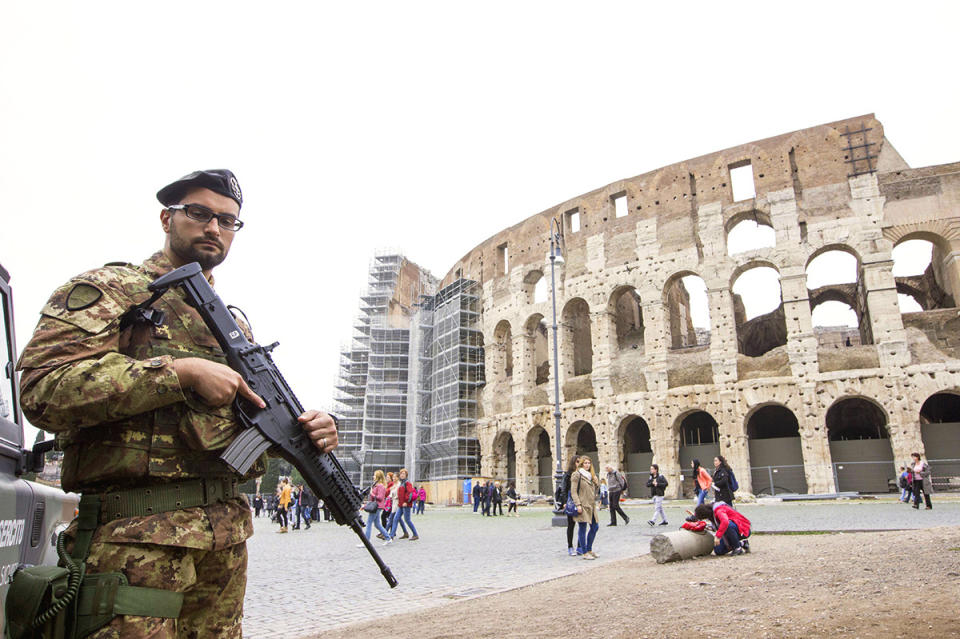Amid Global Travel Alert: Is Anywhere Safe for Tourists?
A rarely used global alert has been issued by the U.S. State Department that asks all travelers to proceed with caution as they make their way around the world. The alert comes on the heels of a series of horrific attacks that have left the world reeling in their wake.
Now is a time for all travelers to ask themselves the question: Where in the world is it safe to go right now?
The U.S. State Department’s Worldwide Travel Alert was issued on Monday evening and explains that current intelligence suggests terrorist groups such as the Islamic State (ISIS), Boko Haram, and al-Qaida are continuing to plan attacks similar to those seen in multiple countries across the globe.
Related: Why I’m Taking the Most Important People in My Life to Paris

French police officers check the border between France and Belgium in Neuville-en-Ferrain, northern France. (AP Photo/Michel Spingler)
“These attacks may employ a wide variety of tactics, using conventional and non-conventional weapons and targeting both official and private interests,” reads the alert, which will remain in place until Feb. 24, 2016.
The U.S government seldom issues this type of warning. In fact, similar warnings have been given only a few times in recent years — following the death of Osama bin Laden in May 2011, on the 10-year anniversary of the 9/11 attacks in September 2011, after threats made by al-Qaida in August 2013, and most recently, following an active shooter attack in Sydney, in December 2014.
Related: Terror Threat in Belgium — What Tourists Need to Know
While the alert does not instruct Americans to stop traveling overseas, it urges those making foreign trips to exercise vigilance when in public places or using public transportation systems.
“Be aware of immediate surroundings and avoid large crowds or crowded places,” the alert says. “Exercise particular caution during the holiday season and at holiday festivals or events.” It also reassures travelers that the government will “continue to work closely with our allies on the threat from international terrorism.”
According to the alert, there are some countries where you’re less likely to experience a terrorist attack and some that are more dangerous. Here’s what you need to know:

In an abandoned subway station in a Lower Manhattan, police stage a drill simulating a terrorist attack on Sunday Nov. 22, in New York. (Photo: AP)
Threats in the United States
Over the past week, there have been several threats against the United States, from an unverified ISIS video with an armed man saying, “By God, as we struck France in the center of its abode in Paris, then we swear that we will strike America at its center in Washington” to a video that showed scenes from New York City’s Times Square, with images of terrorists in suicide belts.
In Washington, D.C., police have deployed extra officers to high-profile targets, such as the Capitol. In New York City, anti-terrorism units are patrolling subway stations near Times Square and Mayor Bill de Blasio and Police Commissioner William Bratton have promised that there will be extra security during Macy’s Thanksgiving Day Parade on Thursday.
On the other hand, Kathy Bedell, senior vice president of BCD Travel, which manages corporate trips, told Yahoo Travel after the threats to Washington, Rome, and London, “We’re telling our clients to send travelers to destinations with elevated risk levels only for business-critical trips.”
Threats in London
The Islamic State threatened London after the Paris attacks. But according to George Taylor, VP of global operations for risk-management firm iJet, the threat didn’t stand out as more dangerous than the other.
London’s last Islamist attack on civilians was in 2005, the coordinated July 7 bombings of the Underground and a double-decker bus that killed 52 people and injured more than 700. But that doesn’t mean the city and the U.K. haven’t faced serious threats since — Prime Minister David Cameron told Radio 4 that British intelligence has foiled seven attacks this year alone.
Since the Paris attacks, Britain has sent its elite special forces to back up undercover police in key London areas such as train stations, the Underground, shopping centers, social hubs, and popular sites. The Telegraph reported that up to 450 radicalized British citizens are estimated to have returned to the U.K. from Syria.
Still, there are no reports of tourist sites being closed, and except for the extra security, it’s business as usual.

Soldiers patrol in front of the Colosseum in Rome, Saturday, Nov. 14, 2015. (Photo: AP Photo/Riccardo De Luca)
Threats in Italy
The U.S. Embassy in Rome has named some of Italy’s most popular tourist attractions as possible targets for terror attacks. St. Peter’s Basilica in the Vatican, La Scala theater in Milan, and the Duomo in Milan, along with more general venues, such as restaurants and hotels, were listed as places that were “at risk.”
In light of the threats made in the wake of the Paris attacks, Italy has raised its threat level to a 2 — which is the highest possible threat level without being a direct attack on Italian soil.
Related: How to Travel Abroad Safely in the Age of Terrorism

French police officers patrol near the Eiffel Tower, Monday Nov. 23, 2015. (AP Photo/Jacques Brinon)
Threats in France
Following the devastating terror attacks in Paris on Nov. 13, the U.S. Embassy in Paris has strongly urged Americans in the country to remain highly vigilant and take steps to maintain their personal security, especially when using public transport, attending high-profile sporting events, or visiting tourist destinations and other public venues.
“Airports and train stations remain open, however travelers may expect delays due to heightened security measures,” the statement read, advising travelers to arrive at airports and train stations in plenty of time.
Some public events in Paris have been canceled, and a tightened police and military presence is noticeable throughout the city.

Police officers patrol the Grand Place in central Brussels, Tuesday, Nov. 24, 2015. (AP Photo/Michael Probst)
Threats in Belgium
The Belgian capital city of Brussels is currently under the highest possible terror alert after intelligence suggested a “serious and imminent threat” from a terrorist attack, similar to that seen in Paris just a week ago.
“We are talking of a threat of several individuals with weapons and explosives, to launch acts, maybe even in several places at once,” Belgian Prime Minister Charles Michel said during a press conference over the weekend.
Since then, the city has been on lockdown with the Métro system, tourist attractions, schools, shops, and restaurants completely closed.
Citizens and visitors alike have been advised to stay in their homes and “hide in place” unless absolutely necessary.
While the airport and major train station in the city are still operational, military and armed police roam the streets and patrol major transport hubs as well as hotels and tourist attractions.
Threats in Turkey
There is currently a high threat of terrorism in Turkey. In October, two explosions near the main train station in Ankara killed 100 people and injured 180 more.
In August, two gunmen opened fire outside the U.S. Consulate in Istanbul.
The country has been under threat from the DHKP-C (Revolutionary People’s Liberation Party Front), which has been targeting Turkish officials.
Russian Foreign Minister Sergey Lavrov recently canceled his own trip to Istanbul due to terror threats. He declared that the current terror threat in Turkey is “not lower than in Egypt” and discouraged his countrymen from visiting.
Threats in Denmark
Denmark is also currently on the list of countries that the State Department is advising travelers to be cautious about visiting.
Following attacks in Paris, the Danish government raised the country’s threat level.
“Following the terrorist attacks in Paris, the Danish police is now raising its internal preparedness level” to “significantly heightened preparedness,” police said in a statement.
Threats in Mali
Gunmen stormed a hotel in the Malian capital, Bamako, last Friday, Nov. 20, taking 170 hostages and killing at least 22.
The attack was believed to have been carried out by Islamist extremists, and authorities are still hunting several people they suspect of having been involved.
In May 2015, the U.S. State Department updated its Mali travel warning, informing American citizens of the risks of travel to the country and stating that the potential for attacks throughout the country was high.
Travel to the northern part of Mali is especially dangerous because of the ongoing threat of attacks and the risks of Westerners being kidnapped.
Threats in Egypt
Terrorist activity and attacks have increased dramatically within Egypt in recent years, and there have been several large-scale attacks linked to ISIS in 2014 and 2015 — including the alleged bombing of a Russian passenger plane on Oct. 31, which killed 224 people.
While the Egyptian government maintains a high level of security around its tourist destinations, travel outside of Cairo, Alexandria, and the main tourist resorts is advised against due to the threat of attacks.
Extremists have been responsible for car bombings, kidnappings, and shootings, and because of their affiliation with ISIS, the threat of future attacks targeting Western civilians and tourists is very high.
Since the plane bombing last month, several airlines have completely suspended flights into Sharm el Sheikh Airport until at least January, because of security concerns.
Threats in Israel
The ongoing, deep-rooted conflict between Israel and Palestine has led to an increased level of violence and civil unrest in the region.
The State Department warns travelers, especially those wishing to visit Jerusalem, to be “aware of the numerous political, cultural, and religious tensions that permeate the city.” It states on its website, “These sensitivities have the potential to fuel protests, civil unrest, acts of terrorism, and retaliatory attacks against groups and individuals. There have been frequent clashes between protesters and Israeli authorities, particularly in East Jerusalem neighborhoods.”

Photo: @StateDept/Twitter
Take Precautions
While the chance of being a victim of a terrorist attack is still very small, it is best to be prepared. According to the U.S. State Department, the number of U.S. citizens killed overseas by incidents of terrorism from 2001 to 2013 was 350. During the same period, 3,030 people were killed by terrorism on American soil. The risk of dying in a terrorist attack is about 1 in 20 million. For comparison’s sake, the risk of being killed in a car crash is about one in 19,000.
Make sure to do research on the country you are traveling to, and make yourself aware of local threats and security issues ahead of time.
Look up local emergency contact numbers, particularly those for the police and the nearest U.S Embassy. Keep these on you and accessible at all times. Do not store them in your phone. You never know when your battery might die or cell service could cut out.
Once U.S. nationals are overseas, the State Department advises them to follow the instructions of local authorities in the host country. Be prepared for additional security screenings and the resulting delays, as well as increased police and military presence in certain cities and urban areas.
Monitor local media and the State Department website, Facebook, and Twitter for up-to-date alerts and security information.
Unfortunately, the worldwide travel alert does not mean you can cancel your flights and hotel reservations and expect a refund if you change your travel plans, but you should contact your individual hotel and airline to find out if you can make adjustments.
WATCH: 7 Ways to Travel Without Fear

